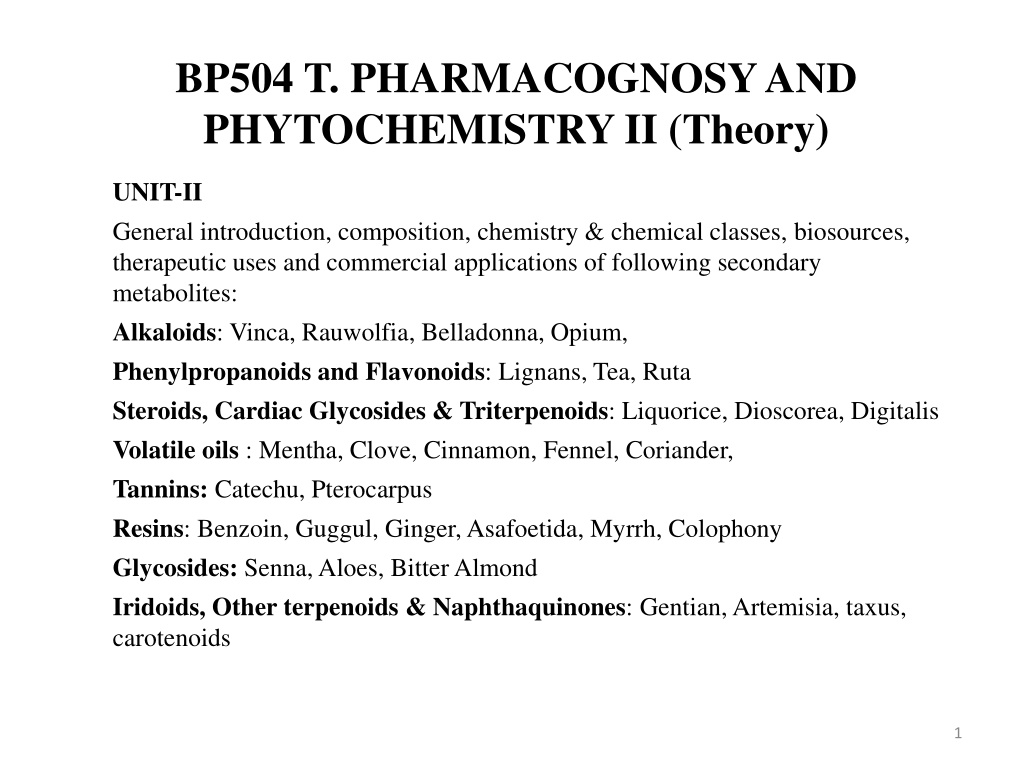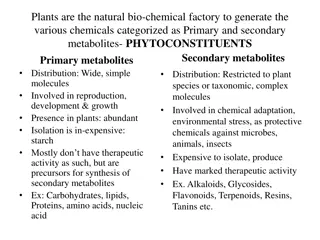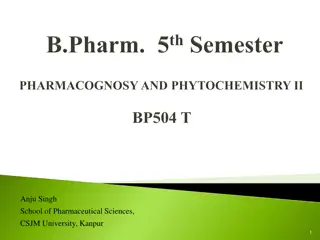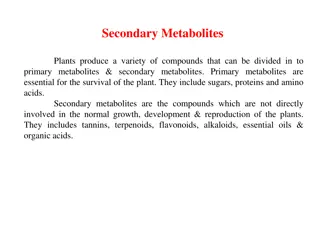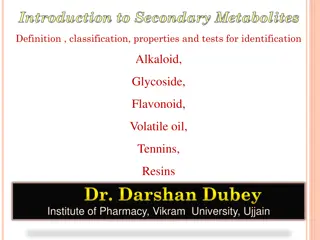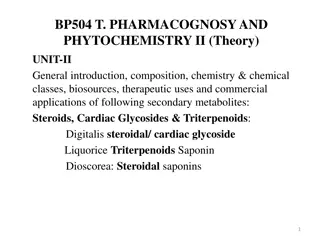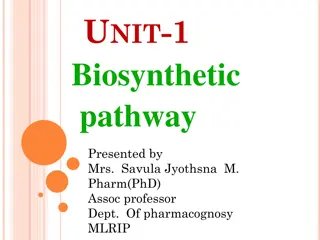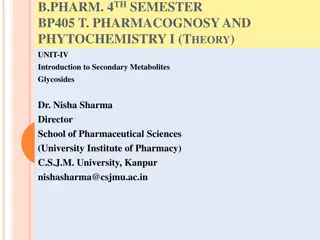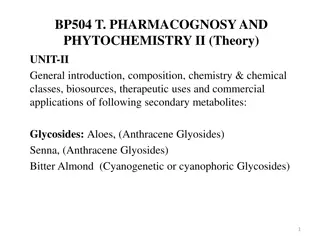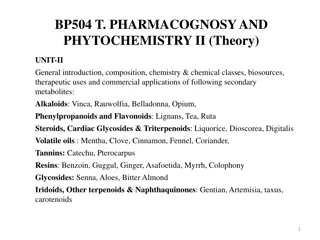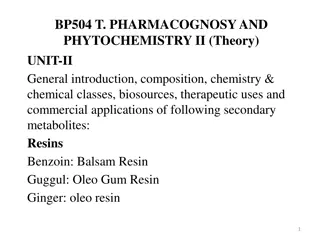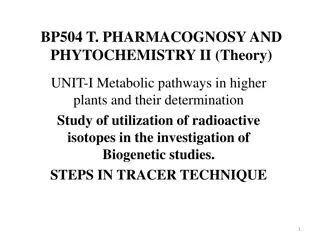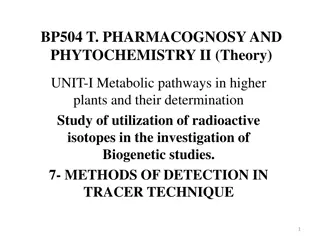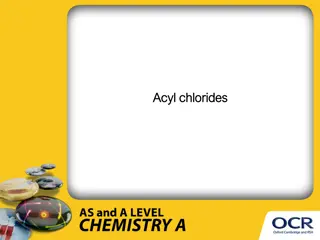Understanding Secondary Metabolites of Rue (Ruta graveolens)
Rue (Ruta graveolens) is a herb known for its medicinal properties and aromatic leaves. It contains various chemical constituents such as flavonoids, alkaloids, fixed oils, and volatile oils. The herb has a long history of traditional uses, including as an insect repellent and a condiment. Chemical analyses have identified furanoacridones, acridone alkaloids, and other compounds in Rue, making it a significant source of bioactive substances.
Download Presentation

Please find below an Image/Link to download the presentation.
The content on the website is provided AS IS for your information and personal use only. It may not be sold, licensed, or shared on other websites without obtaining consent from the author. Download presentation by click this link. If you encounter any issues during the download, it is possible that the publisher has removed the file from their server.
E N D
Presentation Transcript
BP504 T. PHARMACOGNOSY AND PHYTOCHEMISTRY II (Theory) UNIT-II General introduction, composition, chemistry & chemical classes, biosources, therapeutic uses and commercial applications of following secondary metabolites: Alkaloids: Vinca, Rauwolfia, Belladonna, Opium, Phenylpropanoids and Flavonoids: Lignans, Tea, Ruta Steroids, Cardiac Glycosides & Triterpenoids: Liquorice, Dioscorea, Digitalis Volatile oils : Mentha, Clove, Cinnamon, Fennel, Coriander, Tannins: Catechu, Pterocarpus Resins: Benzoin, Guggul, Ginger, Asafoetida, Myrrh, Colophony Glycosides: Senna, Aloes, Bitter Almond Iridoids, Other terpenoids & Naphthaquinones: Gentian, Artemisia, taxus, carotenoids 1
RUTA 2
Introduction to Ruta Ruta is known by the name Rue herb of grace or common rue is grown as an ornamental plant Herb is used for Medicinal prop. used as condiment & as a insect repellent also It has strong smelling leaves It was known to ancient Romans, natural pedanius dioscorides & pliny the elder. They recommended that the rue in combination with poisonous shrub oleander can be taken as an antidote to poisonous snake bites In Southern India, Rue is grown in home gardens to repel snakes 3
RUTA Biological source: consist of entire plant, Ruta graveolens family: Rutaceae Organoleptic characters: color: bluish green leaves, odur: strongly aromatic & characteristic , Taste: pungent , Flower: greenish yellow Chemical constituent: Flavanoid glycoside:Rutin pale yellow color cyrstalline compound Alkaloids: Rutalinium, dictamine, rutamin etc. Fixed oil: linoleic acid, stearic, palimitic, acid Volatile oil: limonene, cineole, ethyl valerate, methyl salicylate, caryophylline, myrecine Others: Psoralin, bergaptin, graveoline, rutarin 4
Chemical constituents Many Furanoacridones & 2 acridone alkaloids arborinine & evoxanthine have been isolated from Ruta graveolens It also contains coumarins & limonoids The ethyl acetate extract of R. graveolens leaves gave 2 furanocoumarins, 1 quinoline alkaloid & quinolone alkaloid The chloroform extract of roots, stem, leaves isolated with furanocoumarin chalepensin Essential oil of R. graveolens contains 2 main constituents undecan-2-one 46%, nonan-2-one 18% It contains coumarins, alkaloids, volatile oils, flavanoids, phenolic acids 5
RUTA Uses: Capillary protectant , antitussive, Spasmolytic, Emmenagoggue (to stimulate menstrual flow) (infusion or liq. extract), Rutin used in combination with ascorbic acid to treat capillary bleeding, blood vessel protectant pharmacological activities including contraceptive, anti-inflammatory, antimicrobial, antipyretic, antioxidant, analgesic, antihyperglycemic, free radical scavenging, hypotensive, antiviral, and antiplasmodial effects. 6
RUTIN also called rutoside, quercetin-3-O-rutinoside and sophorin, is the glycoside combining the flavonol quercetin and the disaccharide rutinose ( -L-rhamnopyranosyl-(1 6)- -D-glucopyranose). It is a citrus flavonoid found in a wide variety of plants including citrus. Rutin on hydrolysis give quercetin and Rhamnose plus glucose 2-(3,4-dihydroxyphenyl)-5,7-dihydroxy-3-[ -L-rhamnopyranosyl-(1 6)- -D- glucopyranosyloxy]-4H-chromen-4-one 7
Tea Thea Sinensis or Camellia thea Dried or prepared leaves, leaf buds of plant Thea sinensis / camellia sinensis belonging to family Theaceae Organoleptic characters: Taste: Bitter, astringent Color: Dark green, Odour agreeable CC.: Condensed tannins, derivatives of Flavanol: Catechin, epicatechin, epigallocatechin, Gallotannic acid (15-20%), epicatechin gallate Purine Alkaloids: Xanthine bases- caffeine 1-3 %, Theobromine, Theophylline in mior amts., enzymatic mixture called thease 8
Tea Thea Sinensis or Camellia thea Trace compounds: Amino acids, proteins, yellow volatile oil (responsible for odor) Color of leaves : because of gallotannic acid Caffeine: 1,3,7, tri methyl xanthine Chemical Test: For caffeine, purine alkaloids Murexide Test: caffeine + KClO3 +HCl Heat to dryness Expose the residue to vapor of dil. NH3 Purple color Caffeine give white ppt. with tannic acid solution Uses: CNS stimulantdue to cerebral vasoconstrictor, In diabetes as diuretic, astringent, antioxidant, beverages, green tea- obesity, weight loss, O CH3 H3C N N N O N CH3 9
TEA Potentiates the action of ergotamine tartarate & enhances the analgesic activity in migraine Tea dust Catechin structure Its flavan-3-ol Natural phenol & antioxidant 2 benzene rings, dihydropyran heterocycle with hydroxyl group on C 3, A ring similar to resorcinol, B is similar to catechol moiety 4 diastereoisomers, 2 are catechin, 2 are epicatechin OH HO O OH OH OH 10
